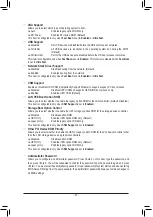
Please visit GIGABYTE's website for details on configuring a RAID array.
Install the SATA RAID/AHCI driver and operating system
With the correct BIOS settings, you are ready to install the operating system.
Installing the Operating System
As some operating systems already include RAID/AHCI driver, you do not need to install separate RAID/AHCI
driver during the Windows installation process. After the operating system is installed, we recommend that you
install all required drivers from the motherboard driver disc using "Xpress Install" to ensure system performance
and compatibility. If the operating system to be installed requires that you provide additional SATA RAID/AHCI
driver during the OS installation process, please refer to the steps below:
1. Copy the
Hw10
folder under the
\BootDrv
folder in the driver disc to your USB thumb drive.
2. Boot from the Windows setup disc and perform standard OS installation steps. When the screen requesting
you to load the driver appears, select
Browse
.
3. Insert the USB thumb drive and then browse to the location of the driver. The location of the drivers is as
follows:
\Hw10\RAID\x64
4. Select
AMD-RAID Bottom Device
first and click
Next
to load the driver. Then select
AMD-RAID Controller
and click
Next
to load the driver. Finally, continue the OS installation.
C. UEFI RAID Configuration
Steps:
1. In BIOS Setup, go to
Boot
and set
CSM Support
to
Disabled
. Save the changes and exit BIOS Setup.
2. After the system reboot, enter BIOS Setup again. Then enter the
Settings\IO Ports\RAIDXpert2
Configuration Utility
sub-menu.
3. On the
RAIDXpert2 Configuration Utility
screen, press <Enter> on
Array Management
to enter the
Create
Array
screen. Then, select a RAID level. RAID levels supported include RAID 0(Stripe), RAID 1(Mirror), and
RAID 10 (the selections available depend on the number of the hard drives being installed). Next, press
<Enter> on
Select Physical Disks
to enter the
Select Physical Disks
screen.
4. On the
Select Physical Disks
screen, select the hard drives to be included in the RAID array and set them
to
Enabled
. Next, use the down arrow key to move to
Apply Changes
and press <Enter>. Then return to
the previous screen and set the
Array Size
,
Array Size Unit
,
Read Cache Policy
and
Write Cache Policy
.
5. After setting the capacity, move to
Create Array
and press <Enter> to begin.
6. After completing, you'll be brought back to the
Array Management
screen. Under
Manage Array Properties
you can see the new RAID volume and information on RAID level, array name, array capacity, etc.
- 41 -
Summary of Contents for TRX40 AORUS PRO WIFI
Page 47: ... 47 ...








































